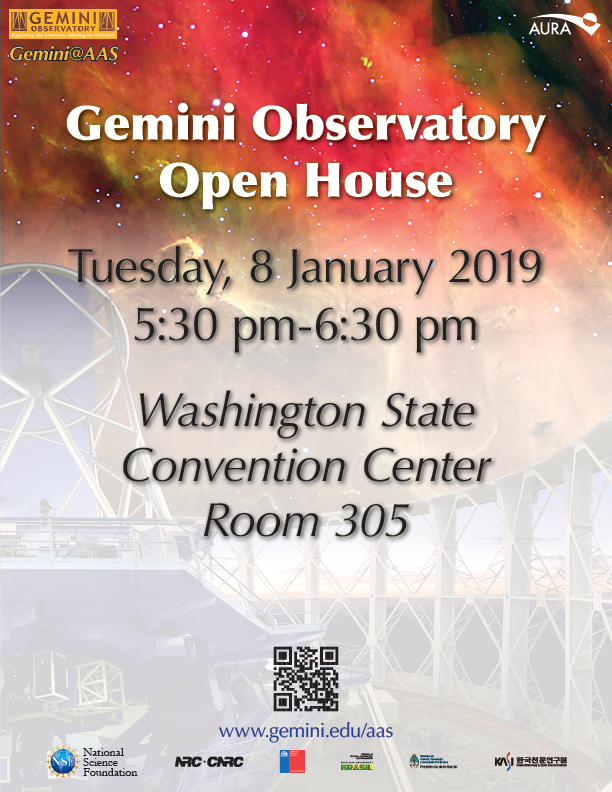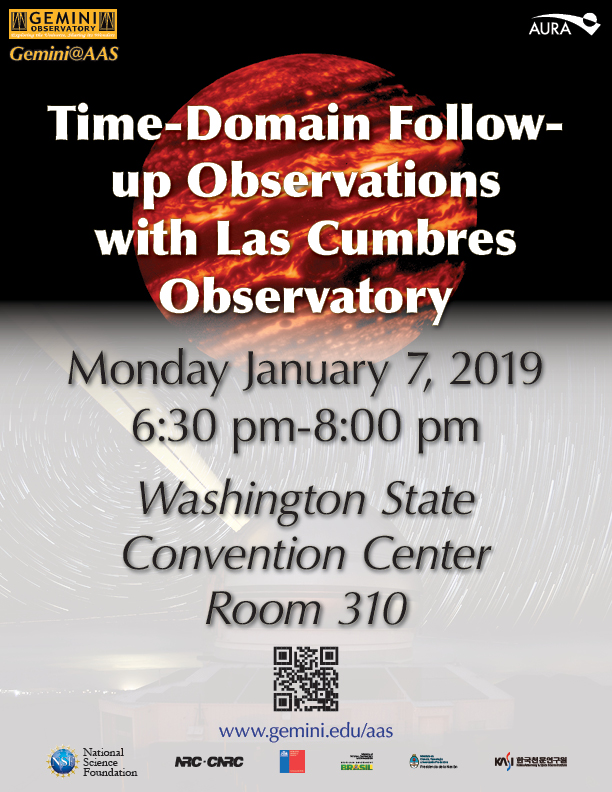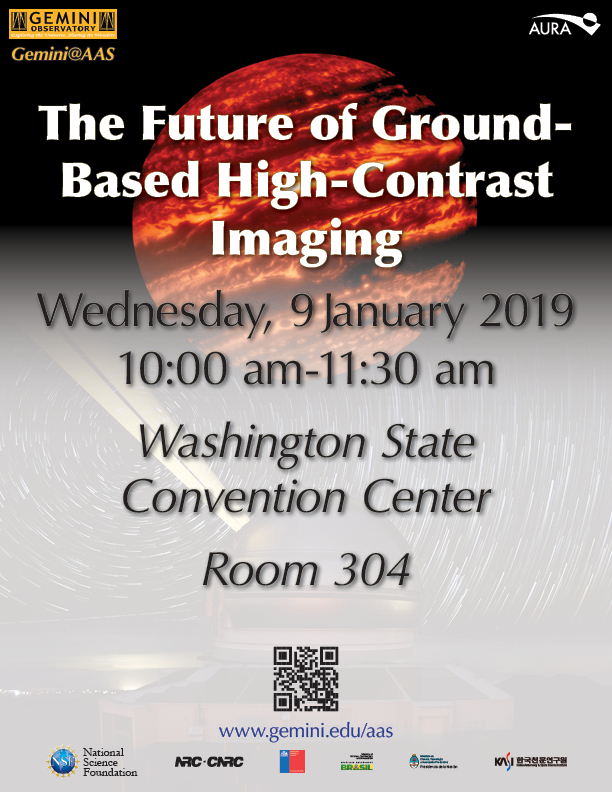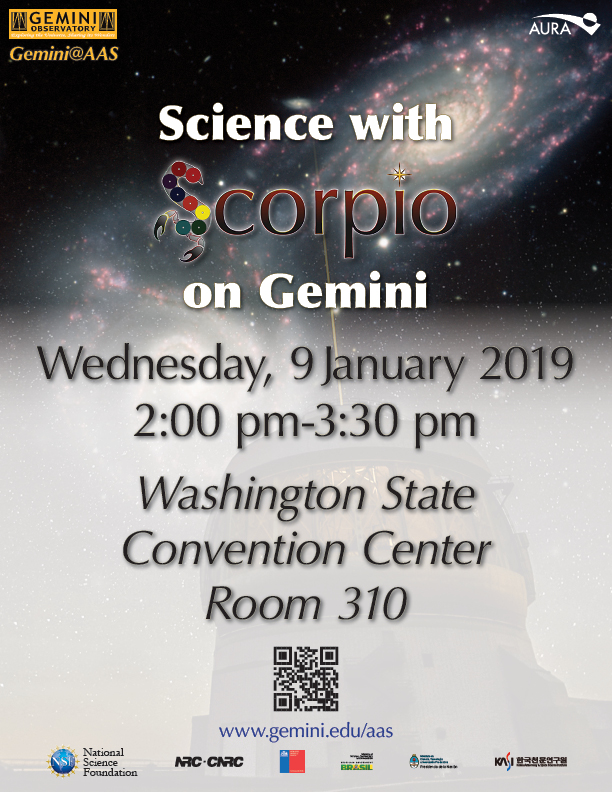Gemini Observatory and its partners will have many events at the 233rd meeting of the American Astronomical Society (AAS), hosted this year in Seattle, Washington during 6–10 January 2019:
- Visit the Gemini Observatory Booth in the Exhibit hall!
- Gemini Observatory Open House
- Time-Domain Follow-up Observations with Las Cumbres Observatory
- NOAO US NGO Mini-Workshop: The Resurgence of High-Resolution Spectroscopy at Gemini
- The Future of Ground-Based High-Contrast Imaging
- Gemini Observatory Workshop: Science with SCORPIO on Gemini
- Talks and Posters featuring Gemini
Visit the Gemini Observatory Booth in the Exhibit Hall at any time!
The Gemini Booth will be situated on the NSF carpet, between the National Solar Observatory and the Large Synoptic Survey Telescope booths. Come to:
- Get the freshest news about the Gemini Observatory
- Get personal support for a proposal, an active program and/or Gemini data reduction
- Get your own deck of the Gemini Card Game!
- Look at our job opportunities
- And more...
Gemini Observatory Open House
Tuesday January 8, 2019: 5:30 pm-6:30 pm, Washington State Convention Center, Room 305
 |
Gemini Observatory invites the community to learn about the latest opportunities for a broad range of science with Gemini’s twin 8.1 m telescopes in Chile and Hawai’i. Gemini’s agile queue operations, broad suite of optical/infrared facility and visiting instruments, and diverse proposal opportunities support a variety on-going programs, including time-domain astronomy, high-spatial and high-spectral resolution studies, exoplanets, and extragalactic astronomy. We discuss progress on the Observatory’s facility instruments under development: GHOST, a high-throughput, high-spectral resolution (R~50-75,000) spectrograph with continuous coverage at 0.36-0.95 microns; and SCORPIO, an 8-channel optical/IR imager and spectrograph with simultaneous coverage from 0.38-2.5 microns. In addition, we describe our visiting instruments program and opportunities for the community to engage with Gemini development efforts. In preparation for the Astro2020 decadal survey, we seek feedback on our long-range strategic plan and roadmap. We are pleased to announce a major new award from the NSF to fund two central elements of our long-range strategic plan: a state-of-the-art wide-field AO system for Gemini North, and improvements to the Observatory’s ability to respond rapidly to transient events in the time-domain era and quickly deliver science-ready data to our users. These are exciting times at Gemini. Click here for Open House Talks |
Time-Domain Follow-up Observations with Las Cumbres Observatory
Monday January 7, 2019: 6:30 pm-8:00 pm, Washington State Convention Center, Room 310
NOAO US National Gemini Office (US NGO) Mini-Workshop: The Resurgence of High-Resolution Spectroscopy at Gemini
Tuesday January 8, 2019: 2:00 pm-3:30 pm, Washington State Convention Center, Room 305
Further details can be found here.
The Future of Ground-Based High-Contrast Imaging
Wednesday January 9, 2019: 10:00 am-11:30 am, Washington State Convention Center, Room 304
Gemini Observatory Workshop: Science with SCORPIO on Gemini
Wednesday January 9, 2019: 2:00 pm-3:30 pm, Washington State Convention Center, Room 310
List of Talks and Posters
Monday, 7 Jan
Posters
| ID | 1st author | Title |
| 140.38 | Mullen, Wyatt | Speckle evolution and post-processing contrast improvements with short exposure imaging on the Gemini Planet Imager |
| 170.01 | Chavez, Joy | Past, Present, and Future Gemini/GSAOI zeropoint calibrations |
| 170.02 | Peck, Alison | Visiting Instruments at Gemini |
| 170.06 | Veach, Todd | SCORPIO Instrument Design and Operational Modes |
| 144.26 | McLain, Shawn | Stellar populations in the tidal debris of NGC 520 |
| 144.31 | Hunt, Qiana | Find the Quenching Mechanism of a z ~ 0.7 Post-Starburst Galaxy |
| 145.07 | Cox, Isabella | Reduction and Analysis of GMOS Spectroscopy for Herschel Sources in CANDELS |
| 145.31 | Roediger, Joel | Seeing Red: Spectroscopy of Galactic Globular Clusters from 6500 Å to 1 µm |
| 140.34 | Nguyen, Meiji | Baade’s Window: An astrometric calibration field for high-contrast imaging of exoplanets |
| 163.04 | Shirman, Nina | Unveiling the Circumstellar Regions of Thermally Pulsing Asymptotic Giant Branch Stars with the Gemini Planet Imager |
| 163.14 | Wolf, Schuyler | Dust properties of the HIP 79977 Debris Disk |
Talks
| ID | Time | 1st author | Title |
| 104.01 | 10:00-10:10am | Macintosh, Bruce | The Gemini Planet Imager Exoplanet Survey: Status and Results |
| 105.04 | 10:40-10:50am | Jensen-Clem, Rebecca | The near-infrared linear polarization of directly imaged exoplanets and brown dwarf companions to main sequence stars |
| 104.07 | 11:00-11:10am | Gerard, Benjamin | The Future of Exoplanet Imaging: the Fast Atmospheric Self-Coherent Camera Technique |
| 104.75 | 11:10-11:20am | Shugart, Alysha | Diversity and inclusion in observatory operations: Advocating for and implementing positive change |
| 114.07 | 11:20-11:30am | Ammons, Stephen | Independent Masses for the Luhman 16AB Binary Brown Dwarf System from Gemini GEMS |
Tuesday, 8 Jan
Posters
| ID | 1st author | Title |
| 242.03 | Ridgway, Susan | GeMS/GSAOI near-infrared imaging of z~0.3 BL Lacs |
| 242.07 | Sameer, Sameer | Investigations of transforming BAL quasars |
| 242.24 | Runnoe, Jessie | A Survey of Kiloparsec-scale Outflows in Nearby Unobscured Quasars |
| 242.26 | Hinkle, Jason | Ionization Mechanisms in Quasar Outflows |
| 242.40 | Choi, Hyunseop | Discovery of a remarkably powerful broad absorption line quasar outflow in SDSS J1352+4239 |
| 243.38 | Matthews, Brandon | Gemini Near Infrared Spectrograph Distant Quasar Survey: The First Year |
| 245.21 | Melnick, David | Developing Novel Algorithms to Recover Faint Circumstellar Shell Structures from ADI data |
| 246.01 | Seth, Anil | The Demographics of Central Massive Black Holes in Low-Mass Early-Type Galaxies |
| 250.07 | Miller, Bryan | The GeMS/GSAOI Galactic Globular Cluster Survey (G4CS) |
| 259.08 | Allen, Michaela | Backyard Worlds: Planet 9 --- The Coldest Discoveries |
| 259.14 | Ward-Duong, Kimberly | Gemini Planet Imager Spectroscopy of the Extremely Red Brown Dwarf Companion HD206893 B |
| 258.16 | Howell, Dale | The Global Supernova Project |
Talks
| ID | Time | 1st author | Title |
| 218.03 | 10:20-10:30am | Kalas, Paul | The International Beta Pic b Transit Campaign |
| 223.01 | 2:00-2:10pm | Panwar, Vatsal | The GEMINI/GMOS optical transmission spectral survey of close-in gas giant exoplanets |
| 226.01 | 2:00-2:10pm | Wang, Jason | Dynamical Constraints on the HR 8799 Planets with GPI |
| 223.03 | 2:30-2:40pm | Pearson, Kyle | Constraints on the Na abundance of XO-2 b using ground-based mutli-object spectroscopy |
| 238.04 | 2:40-2:50pm | Robberto, Massimo | An Overview of SCORPIO, the Gemini-South Facility Instrument for LSST Follow-Up |
Gemini Observatory Open House
| Talk Title | Speaker |
| Gemini Observatory Overview & Strategic Vision | Jennifer Lotz, Gemini Observatory |
| Gemini Planet Imager Science and Future | Quinn Konopacky, UC San Diego |
| Gemini in the Era of Multi-Messenger Astronomy (GEMMA) | John Blakeslee, Gemini Observatory |
Wednesday, 9 Jan
Posters
| ID | 1st author | Title |
| 355.14 | Wilde, Matthew | CGM2: COS+Gemini Mapping of the Circumgalatcic Medium |
| 356.09 | Steele, Rochelle | Surveying for void galaxies with new photometric methods |
Talks
| ID | Time | 1st author | Title |
| 317.02D | 10:10-10:30am | Ren, Bin | Detection and Characterization of Circumstellar Disks in Scattered Light with Space- and Ground-based Telescopes |
| 306.04 | 10:50-11:00am | Crenshaw, D. Michael | Determining the Kinematics of Ionized and Molecular Gas in Nearby Active Galaxies with the Gemini Near Infrared Field Spectrometer (NIFS) |
| 330.02D | 2:10-2:30pm | Roberts, Caroline | The Supermassive Black Hole Mass of NGC 4151 from Stellar Dynamical Modeling |
| 333.02D | 2:10-2:30pm | Kumari, Nimisha | Spatially-resolved studies of nearby star-forming galaxies |
| 335.02 | 2:20-2:30pm | Rho, Jeonghee | NEAR-INFRARED SPECTROSCOPY OF SN 2017EAW: CARBON MONOXIDE AND DUST FORMATION IN A TYPE II-P SUPERNOVA |
| 330.03D | 2:30-2:50pm | Gnilka, Crystal | Feeding vs Feedback in the Narrow Line Region: the Morphology and Kinematics of Mrk 3 |
| 340.05 | 3:00-3:10pm | Esposito, Thomas | 28 Debris Disks Resolved on Solar System Scales with the Gemini Planet Imager |
Thursday, 10 Jan
Posters
| ID | 1st author | Title |
| 455.03 | Andersen, Morten | The Gemini Fast Turnaround program |
| 452.01 | Smith, Adam | Gemini Observatory Cloud Cameras: Usage in Remote Operations and Public Outreach |
| 418.02 | Heinze, Aren | Large Surveys Find Extreme Objects: A Case Study from the ATLAS Variable Star Catalog |
Talks
| ID | Time | 1st author | Title |
| 418.09 | 11:20-11:30am | Van Der Horst, Alexander | Science with SCORPIO on Gemini in the 2020s |
| 436.03 | 2:20-2:30pm | Mazoyer, Johan | The surprising scattering phase function of the HR 4796 debris disk |
| 436.05 | 2:50-3:00pm | Salyk, Colette | A high resolution mid-infrared survey of water emission from protoplanetary disks |
| 423.08 | 3:10-3:20pm | Howell, Steve | Resolving the TESS Planet Population with High Resolution Imaging |
----
Your contribution presents Gemini related work and it is not listed here? Please send details to sus_inquiries@gemini.edu.




